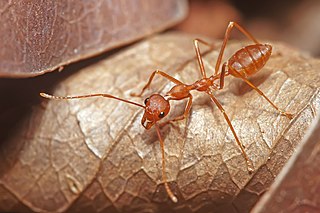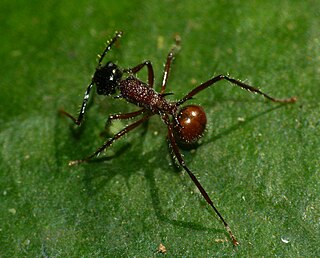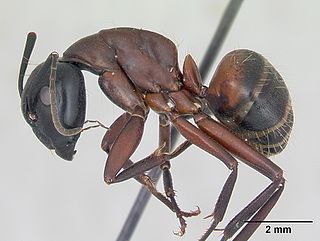
Honeypot ants, also called honey ants, are ants which have specialized workers that consume large amounts of food to the point that their abdomens swell enormously. Other ants then extract nourishment from them, through the process of trophallaxis. They function as living larders. Honeypot ants belong to any of several genera, including Myrmecocystus and Camponotus. They were first documented in 1881 by Henry C. McCook, and described further in 1908 by William Morton Wheeler.

Atta is a genus of New World ants of the subfamily Myrmicinae. It contains at least 17 known species.

Fire ants are several species of ants in the genus Solenopsis, which includes over 200 species. Solenopsis are stinging ants, and most of their common names reflect this, for example, ginger ants and tropical fire ants. Many of the names shared by this genus are often used interchangeably to refer to other species of ant, such as the term red ant, mostly because of their similar coloration despite not being in the genus Solenopsis. Both Myrmica rubra and Pogonomyrmex barbatus are common examples of non-Solenopsis ants being termed red ants.

An instar is a developmental stage of arthropods, such as insects, which occurs between each moult (ecdysis) until sexual maturity is reached. Arthropods must shed the exoskeleton in order to grow or assume a new form. Differences between instars can often be seen in altered body proportions, colors, patterns, changes in the number of body segments or head width. After shedding their exoskeleton (moulting), the juvenile arthropods continue in their life cycle until they either pupate or moult again. The instar period of growth is fixed; however, in some insects, like the salvinia stem-borer moth, the number of instars depends on early larval nutrition. Some arthropods can continue to moult after sexual maturity, but the stages between these subsequent moults are generally not called instars.

Weaver ants or green ants are eusocial insects of the Hymenoptera family Formicidae belonging to the tribe Oecophyllini. Weaver ants live in trees and are known for their unique nest building behaviour where workers construct nests by weaving together leaves using larval silk. Colonies can be extremely large consisting of more than a hundred nests spanning numerous trees and containing more than half a million workers. Like many other ant species, weaver ants prey on small insects and supplement their diet with carbohydrate-rich honeydew excreted by scale insects (Hemiptera). Weaver ant workers exhibit a clear bimodal size distribution, with almost no overlap between the size of the minor and major workers. The major workers are approximately 8–10 mm (0.31–0.39 in) in length and the minors approximately half the length of the majors. Major workers forage, defend, maintain, and expand the colony whereas minor workers tend to stay within the nests where they care for the brood and 'milk' scale insects in or close to the nests.

Carpenter ants are large ants indigenous to many forested parts of the world.

Tapinoma melanocephalum is a species of ant that goes by the common name ghost ant. They are recognised by their dark head and pale or translucent legs and gaster (abdomen). This colouring makes this tiny ant seem even smaller.

Paratrechina is one of seven ant genera in the Prenolepis genus-group from the subfamily Formicinae. Six species are included in Paratrechina; one of which, the longhorn crazy ant, is a widespread, pantropical pest.

The banded sugar ant, also known as the sugar ant, is a species of ant native to Australia. A member of the genus Camponotus in the subfamily Formicinae, it was described by German entomologist Wilhelm Ferdinand Erichson in 1842. Its common name refers to the ant's liking for sugar and sweet food, as well as the distinctive orange-brown band that wraps around its gaster.

Solenopsis molesta is the best known species of Solenopsisthief ants. They get their names from their habit of nesting close to other ant nests, from which they steal food. They are also called grease ants because they are attracted to grease. Nuptial flight in this species occur from late July through early fall.

Solenopsis saevissima, commonly known in Brazil as formiga de fogo, formiga-vermelha, or formiga-lava-pes, is one of more than 185 species in the genus Solenopsis. It, along with 13 other species, is also a member of the Solenopsis saevissima species group which are popularly known as fire ants.

Amoimyrmex striatus is a species of leafcutter ant found in the Neotropics.

The longhorn crazy ant, also known as the black crazy ant, is a species of small Formicine ant. These ants are commonly called "crazy ants" because instead of following straight lines, they dash around erratically. They have a broad distribution, including much of the tropics and subtropics, and are also found in buildings in more temperate regions, making them one of the most widespread ant species in the world. This species, as well as all others in the ant subfamily Formicinae, cannot sting. However, this species can fire/shoot a formic acid spray from its abdomen when under attack by other insects or attacking other insects. When the longhorn crazy ant bends its abdomen while aiming at an enemy insect, it is typically shooting its hard-to-see acid.

Polyrhachis is a genus of formicine ants found in the Old World with over 600 species. The genus is yet to be comprehensively resolved and contains many varied species including nest-weavers, swimming workers, soil and tree-dwellers. First fossil record of this genus was P. annosa from Miocene.

Camponotus japonicus, commonly known as the Japanese carpenter ant, is a species of ant native to eastern Asia. It is black, and one of the largest ants. A nest has about ten to thousands of individuals, and it can be a pest when it enters households or protects aphids. There are several subspecies of this ant in different areas of Asia, with the largest of the species being located in northern China.

Linepithema micans is a small species of ant from the genus Linepithema which was described by Auguste-Henri Forel in 1908. This ant is endemic to southern South America. In Brazil, it is considered a pest of vineyards in acting as the main species associated with the coccid Eurhizococcus brasiliensis. It is still a poorly studied species. Their abundant larvae are round and whitish, almost indistinguishable from the proximate species Linepithema humile, better known as the invasive Argentine ant.

Polybia paulista is a species of eusocial wasp occurring in Brazil, Paraguay, and Argentina.
Camponotus vittatus is a species of carpenter ant and one of the most common ants found around households in South America, particularly Brazil. It was originally described by Auguste Forel in 1904. The species is relatively large, caramel-coloured, omnivorous, and fast-moving. The species presents four larval stages which will spin a cocoon to pupate. The hairs of Camponotus larvae are quite abundant, and may present taxonomic importance. The larvae of both sexes are similar, with few diagnostic traits, such as the acquired shape towards pupation inside their cocoons.

Camponotus senex is a fairly common species of weaver ant from the New World. They are opportunistic cavity-dwellers, semi-nomadic carpenter ants which are found around grasslands in Central and South America. It is taxonomically believed to be a complex of cryptic species and was previously considered synonymous with Camponotus textor which once included a distantly-related species of weaver-ant.

Camponotus ligniperda, the brown-black carpenter ant, is a common species of carpenter ant distributed widely throughout Europe. Found in a variety of woodland habitats, they commonly nest on the ground in dry tree stumps, dead fallen trees, or beneath stones and wooden logs that are partially buried. C. ligniperda is an ecologically dominant species wherever it is found due to both its large size and particularly aggressive nature.

















